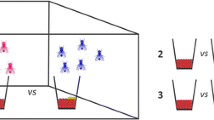Abstract
Females of Parastrachia japonensis (Hemiptera: Cydnidae) provision nymph-containing nests with drupes of the single host tree, Schoepfia jasminodora (Rosidae: Santales). P. japonensis feeds on the endosperm of these drupes. Foraging females approached and accepted only a few selected drupes for transport to their nests from among the hundreds of drupes scattered on the ground. The characteristics of the drupes that elicited an acceptance response under field conditions were examined. Females estimated the degree of endosperm development using volatile and nonvolatile chemicals in the outer skin as cues and selected only those drupes which had a well-developed endosperm. Although the cues that prompted approach and inspection of a drupe are in the fleshy outer skin, females presented with various substitute drupes coated with outer skin juices of acceptable drupes selected only those they could recognize as a solid mass, suggesting that they used volatile chemicals in the outer skin as cues for approaching and inspecting a drupe and then taste and tactile stimuli as cues for acceptance. Thus, this bug possesses a complex, ecologically sensitive cognitive system that enables it to recognize valuable food items by using reliable cues. The importance of selective foraging by P. japonensis females and the evolutionary significance of this behavior are discussed.
Similar content being viewed by others
REFERENCES
Eickwort, G. C. (1981). Presocial insects. In Hermann, H. R. (ed.), Social Insects, Vol. 2, Academic Press, New York, pp. 199–280.
Filippi-Tsukamoto, L., Nomakuchi, S., Kuki, K., and Tojo, S. (1995a). Adaptiveness of parental care in Parastrachia japonensis (Hemiptera: Cydnidae). Ann. Entomol. Soc. Am. 88: 374–383.
Filippi-Tsukamoto, L., Nomakuchi, S., and Tojo, S. (1995b). Habitat selection, distribution, and abundance of Parastrachia japonensis (Hemiptera: Cydnidae) and its host tree. Ann. Entomol. Soc. Am. 88: 456–464.
Kight, S. L. (1995). Do maternal burrower bugs, Sehirus cinctus Palisot (Hemiptera: Cydnidae), use spatial and chemical cues for egg discrimination? Can. J. Zool. 73: 815–817.
Michener, C. D. (1969). Comparative social behavior of bees. Annu. Rev. Entomol. 14: 299–342.
Nakahira, T. (1991). Provisioning behavior of Adomeris triguttulus. Abstracts of the 35th Meeting of the Japanese Society of Applied Entomology and Zoology, Shizuoka, Japan.
Sites, R. W., and McPherson, J. E. (1982). Life history and laboratory rearing of Sehirus cinctus (Hemiptera: Cydnidae). Ann. Entomol. Soc. Am. 75: 210–215.
Stephens, D. W., and Krebs, J. R. (1986). Foraging Theory, Princeton University Press, Princeton, NJ.
Tachikawa, S. (1991). Studies on Subsocialities of Heteroptera in Japan, Tokyo Agricultural University Press, Tokyo (in Japanese).
Tachikawa, S., and Schaefer, C. W. (1985). Biology of Parastrachia japonensis (Hemiptera: Pentatomoidea: ?-idae). Ann. Entomol. Soc. Am. 78: 387–397.
Tallamy, D., and Denno, R. F. (1981). Maternal care in Gargaphia solani (Hemiptera: Tingidae). Anim. Behav. 29: 771–778.
Tallamy, D. W., and Wood, T. K. (1986). Convergence patterns in subsocial insects. Annu. Rev. Entomol. 31: 369–390.
Tsukamoto, L., and Tojo, S. (1992). A report of progressive provisioning in a stink bug, Parastrachia japonensis (Hemiptera: Cydnidae). J. Ethol. 10: 21–29.
Wilson, E. O. (1971). The Insect Societies, Harvard University Press, Cambridge, MA.
Wilson, E. O. (1975). Sociobiology: The New Synthesis, Belknap, Harvard University Press, Cambridge, MA.
Author information
Authors and Affiliations
Rights and permissions
About this article
Cite this article
Nomakuchi, S., Filippi, L. & Tojo, S. Selective Foraging Behavior in Nest-Provisioning Females of Parastrachia japonensis (Hemiptera: Cydnidae): Cues for Preferred Food. Journal of Insect Behavior 11, 605–619 (1998). https://doi.org/10.1023/A:1022305423994
Issue Date:
DOI: https://doi.org/10.1023/A:1022305423994




